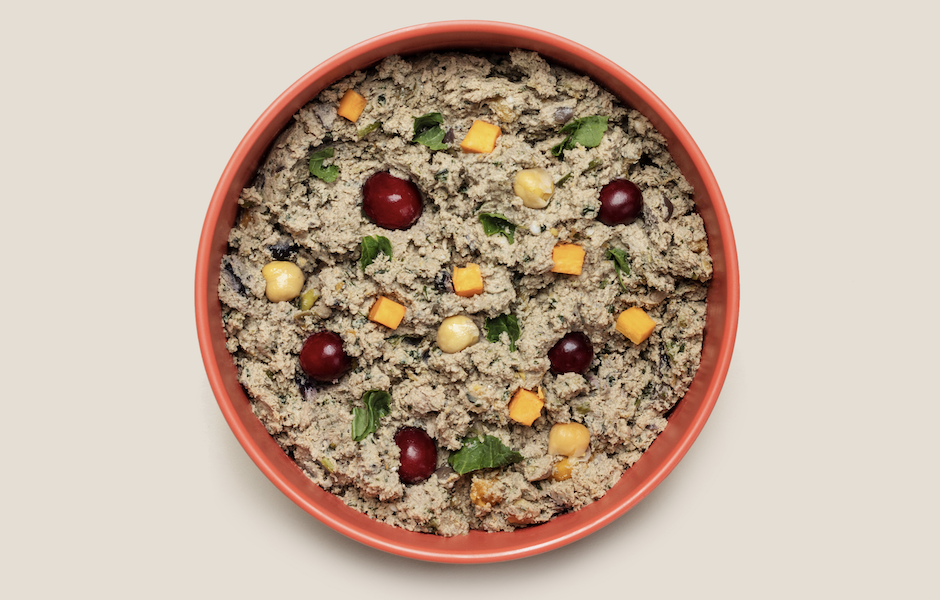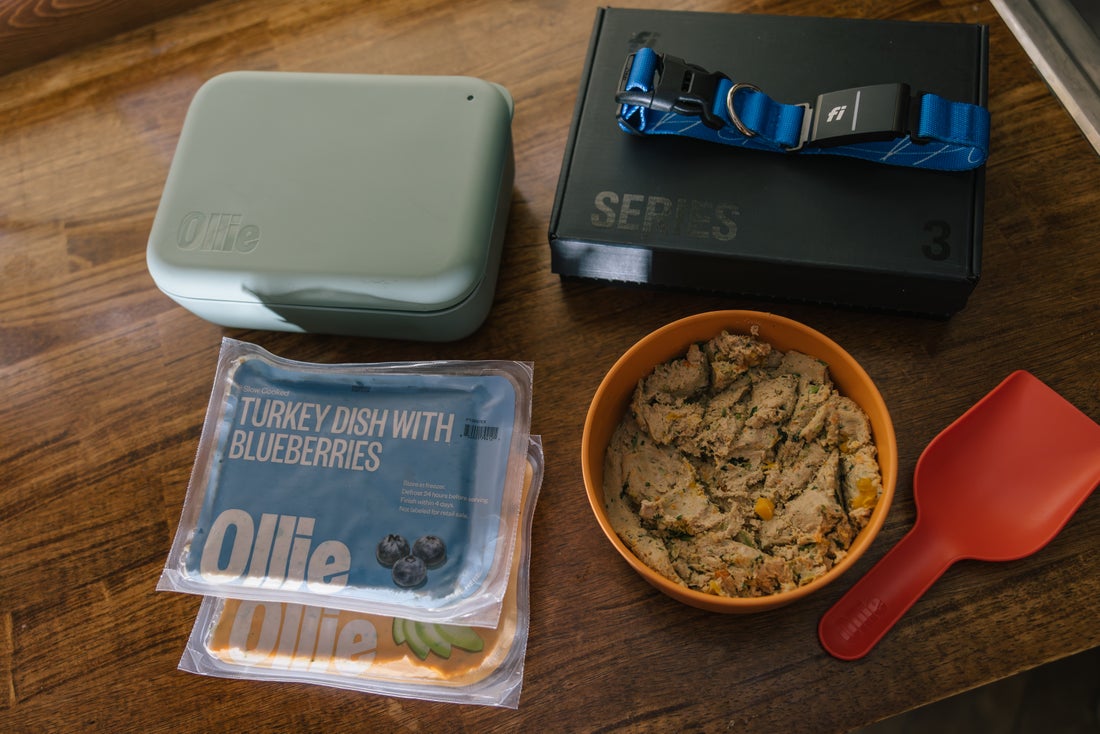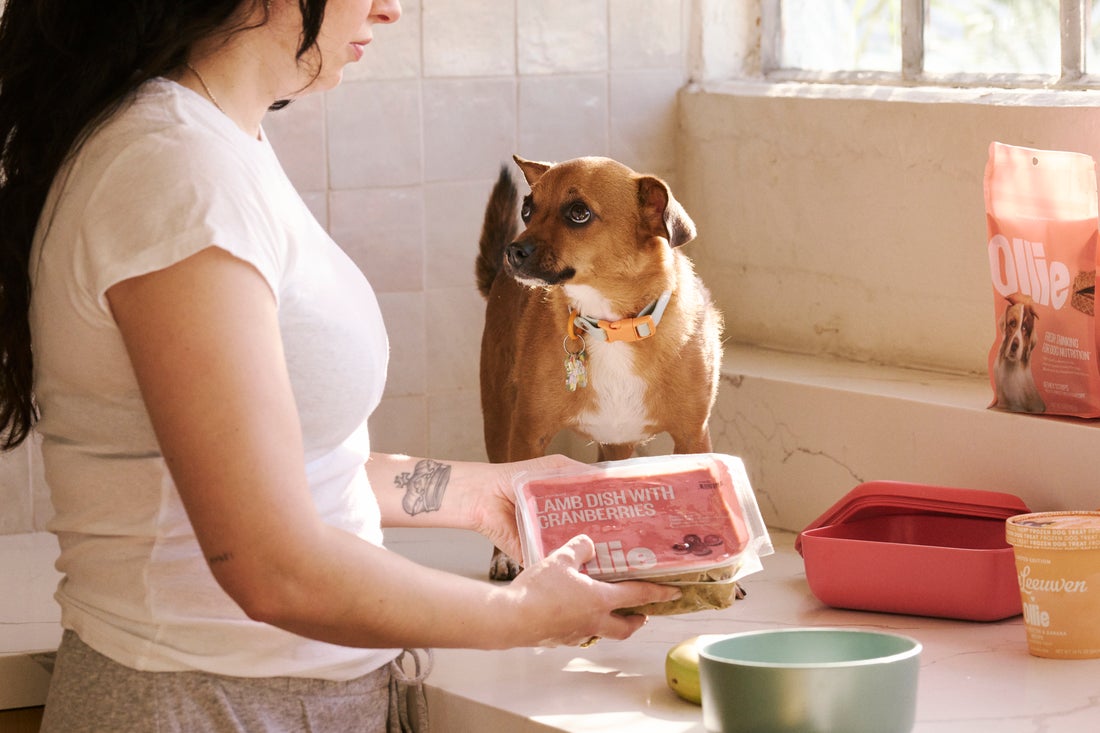Hey Ollie blog readers! We’re offering you an exclusive 60% OFF your starter box! Try now!
The Science Behind Pancreatitis in Dogs
Pancreatitis is inflammation of your dog’s pancreas, a small organ that produces, stores, and releases digestive enzymes and blood glucose-regulating insulin. When the pancreas is inflamed or irritated, the stored digestive enzymes are prematurely released. According to Brooks, this untimely enzyme rush results in a “metabolic catastrophe,” as inflamed pancreatic tissue releases additional toxins, triggering widespread inflammation throughout an affected dog’s body. Pancreatitis can be acute or chronic, and both types can be mild or severe. According to Hanzlicek, each pancreatitis type has a similar onset, with signs that include vomiting, stomach pain, and appetite loss. Consider each pancreatitis type’s facts:- Acute pancreatitis — Acute pancreatitis occurs suddenly and usually with significant pain and illness signs. An affected dog may have no previous pancreatitis history. Without prompt veterinary treatment, which often requires hospitalization to address pain, inflammatory damage, and dehydration, a severely affected dog can experience shock or die.
- Chronic pancreatitis — Chronic pancreatitis progresses gradually and may go undetected for months or years. Symptoms of chronic pancreatitis in dogs may be subtle and nonspecific unless an acute flare-up (i.e., acute-on-chronic pancreatitis) occurs. Over time, persistent pancreatic inflammation can compromise a dog’s pancreatic function, resulting in secondary conditions and complications.
Why Do Dogs Get Pancreatitis?
This is the million-dollar question. Unfortunately, the answer is multifaceted and murky. For many affected dogs, a clear underlying cause is never determined. However, for some dogs who develop pancreatitis, one or more of these known causes can be to blame:- High-fat diets — According to Hanzlicek, high-fat diets and foods are primary pancreatitis culprits, especially if the food is introduced abruptly. “We often hear about the dog who gets into the trash and eats something fatty,” Hanzlicek says. Pancreatitis can also develop over time if an affected dog has a history of consuming fatty foods .
- Other health conditions — Pancreatitis can occur secondary to other conditions including obesity, diabetes, and endocrine diseases such as hypothyroidism. “It may also be caused by trauma to the pancreas from a car accident or from a tumor,” explains Brooks.
- Certain genetically predisposed breeds — Some breeds, such as miniature schnauzers, have an elevated pancreatitis risk. This is because they typically have altered fat metabolism.
How Is Pancreatitis in Dogs Diagnosed?
If you suspect your dog has pancreatitis, immediately contact your veterinarian. Timely and accurate diagnosis is the best way to minimize your dog’s inflammation and pain, and reduce their serious complication risk. Your veterinarian will begin by taking a thorough history, including information about your pup’s clinical signs and details about their diet and behavior. This helps your veterinarian determine if high-fat foods are to blame for your dog developing the condition. Your veterinary professional will then perform a physical examination to assess your dog’s hydration status and pain level, and look for signs that may indicate other conditions (e.g., diabetes, endocrine diseases). After the examination, your veterinarian will perform diagnostic testing to pinpoint the cause of your pup’s illness. Diagnostic testing may include:- Standard and specific blood work — In addition to standard blood work (e.g., a complete blood count and general chemistry), pancreas-specific testing is commonly used to measure pancreatic enzymes in your pup’s body. The specific canine pancreatic lipase (SPEC cPL) test is considered a highly sensitive and specific test, detecting 83% of pancreatitis cases. In addition, this diagnostic test is quick, convenient, and affordable.
- Abdominal ultrasound — Ultrasound imaging is a noninvasive way to visualize a dog’s abdominal organs and look for tissue damage, swelling, and inflammation. However, ultrasound’s accuracy falls short of the SPEC cPL test, detecting roughly only 68% of pancreatitis cases in dogs.
Treatment Options for Pancreatitis
Pancreatitis treatment varies based on the condition’s severity and onset, as well as your dog’s signs. Your veterinarian will devise an individual plan for your pup and make specific long-term care recommendations. Treatment focuses on managing symptoms of pancreatitis in dogs rather than on providing a definitive cure. As such, most treatment plans address the condition from several angles, including:- Fasting — Fasting can help your pup’s overtaxed pancreas recover and heal. Your veterinarian will guide you on when to reintroduce food, starting with a low-fat bland diet.
- Symptom relief — Veterinarian-prescribed pain and anti-nausea medications can ease a dog’s pancreatitis-related discomfort and illness. According to Hanzlicek, medication may be all that is necessary for mild cases.
- Intensive care — Hospitalization and intravenous (IV) fluid therapy may be necessary if your dog shows severe pancreatitis signs.
- Diet — Unlike highly processed foods that can be hard on your pup’s system, fresh food diets, such as Ollie, are easily digestible, allowing your dog to receive maximum nutrition that supports—rather than irritates—normal body function.
Are Long-Term Issues Associated with Pancreatitis?
Although most dogs who receive pancreatitis treatment enjoy a positive outcome, frequent pancreatitis flare-ups and unmanaged chronic pancreatitis can lead to long-term damage and complications. Long-term issues associated with pancreatitis may include:- Diabetes mellitus — Damaged pancreatic tissue cannot produce insulin in adequate amounts, resulting in uncontrollable blood glucose levels and diabetes.
- Exocrine pancreatic insufficiency (EPI) — Tissue damage can also compromise digestive enzyme production, resulting in an inability to process and absorb food nutrients. Dogs with EPI must be managed with supplemental enzymes.
Ways to Prevent Pancreatitis in Dogs
Unfortunately, pancreatitis isn’t always preventable, especially if your dog is genetically predisposed to this painful and frustrating disease. However, you can take several steps to lower your dog’s pancreatitis risk and support normal pancreatic function such as:- Feeding a healthy low-fat diet — If your dog is at risk for pancreatitis, Hanzlicek recommends feeding a healthy, relatively low-fat diet, such as salmon, chicken, and turkey, which are low-fat proteins, and avoid feeding your pup fatty scraps. Feeding smaller, more frequent meals may also ease the pancreas’s workload. Fresh dog food, such as Ollie, is a great way to ensure your dog receives maximum nutrition that’s highly palatable and easy to digest.
- Supplementing your dog’s diet — Some studies have shown that vitamins E and C, beta-carotene, and methionine can help reduce a dog’s pancreatitis risk. Fish oil is also a great option because this supplement naturally lowers blood lipid levels. Always talk with your veterinarian before adding supplements to your dog’s diet.
- Staying up-to-date on veterinary care — Yearly or twice-yearly veterinary wellness examinations and blood work are the best way to ensure early detection for a number of chronic canine conditions, including pancreatitis.
- Managing your dog’s weight — Regular exercise and a fresh healthy diet, like Ollie, is the perfect combination for achieving and maintaining your dog’s ideal weight. Because excess body fat is linked to a laundry list of chronic inflammatory diseases and a shorter life span, this small step can significantly promote your pup’s long-term health.


Find Out Which Recipe Plan is Right for Your Dog’s Needs
Get 50% of your first box of Ollie’s fresh delivered meals today!
Take our 5-Minute Quiz!Tagged As:

The nutrition your dog needs,
the food they want.

Enjoying our articles? Subscribe our Newsletters and get new articles directly to your inbox
You might also like
18 September 2025
5 MINS READ
Can I Rotate Fresh Dog Food Flavors?
Yes, it’s safe to rotate fresh dog food flavors, and many dogs actually benefit from the variety. At Ollie, we offer multiple fresh recipes, like Beef, Chicken, Turkey, Lamb, and Pork so you can…
by Ollie Pets
18 September 2025
5 MINS READ
Is Fresh Dog Food Safe During Power Outages?
Fresh dog food is only safe during a power outage if it has stayed cold, specifically, below 40°F. Once the temperature rises above that point, bacteria can start to grow, and the food may no lon…
by Ollie Pets
18 September 2025
5 MINS READ
How Do I Store Fresh Dog Food While Traveling?
If you’re bringing fresh dog food on the road, keeping it cold is key. The best way to store it is in a cooler with ice packs or a travel freezer. At Ollie, our vacuum-sealed fresh food stays good…
by Ollie Pets







